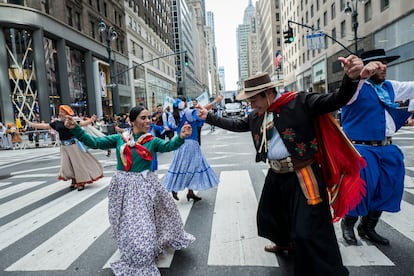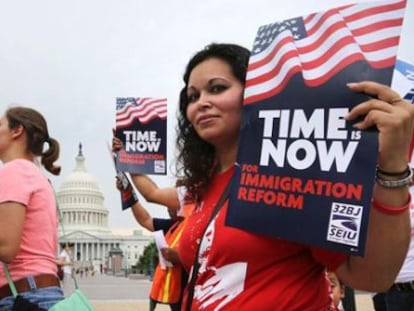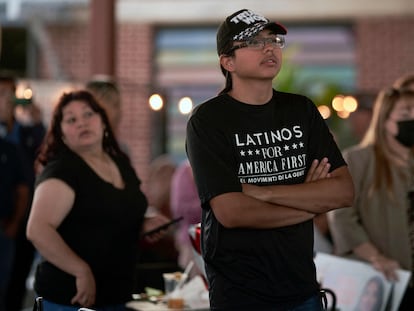40 years of being #Hispanic-Latino-Latinx in the US
My immigrant story is not a very traditional story but, ultimately, it is one more page in the book that we are writing here in the United States

Back in 1983 I began my “American dream” in this country that has given me so much in the last 40 years, a great family, two children, lots of work and great experiences.
My immigrant story is not a very traditional story but, ultimately, it is one more page in the book that we Latinos are writing here in the United States.
Who would have told me that that young Mexican who came to spend a summer in Los Angeles, California (a grandson of two constituent deputies from my father’s and mother’s countries of origin: Rafael Martínez Mendoza, a constituent of Mexico in 1917 and Jerónimo Gomariz La Torre, a constituent of the Second Spanish Republic) would end up working in five presidential elections in the United States of America, producing and directing messages for the candidates running for the most important position in this country. Messages from candidates like George W. Bush, John McCain, Mitt Romney and Jeb Bush, aimed at the increasingly coveted Hispanic voter. But also producing attack messages against the man who made his main campaign banner attacking us, Donald J. Trump; and who we gladly managed to defeat together with The Lincoln Project, many other organizations and millions of Hispanics who joined so that he would not be reelected.
A country where Latinos increasingly play a more important role
An unexpected path led me to study cinema in Hollywood and to the distribution of Mexican cinema in Spanish-language theaters in many parts of the country with Azteca Films.
But mine is just one of those millions of Latino stories that are written every day across America.
To make a short summary of what we Latinos have advanced in these four decades, let’s look at the numbers from where we were 40 years ago, where we are now and where we are heading to.
In the early eighties we were less than 15,000,000 Hispanics, only a quarter of what we are today. There were less than a dozen Latino congress-members, a single Latino Governor, John Sununu of New Hampshire, born in Cuba to a Salvadoran mother. There were no Latino senators at the time, and we had only had three in the entire 20th century. There were some mayors like Federico Peña who made history as the first Latino mayor of Denver, Colorado, but no member of the presidential cabinet.
The president was Ronald Reagan, ex-governor of California and someone who understood the importance of Latinos, of immigrants, very well. So much so that he was the one who proposed and achieved a comprehensive immigration reform in 1986, something no other president has achieved. And, in fact, he was also the first to appoint a Latino as a member of his cabinet: Lauro Cavazos as Secretary of Education.
Today, according to the last census, we are 62,080,044 Hispanics, 18.9% of the population, that is, one out of every fve Americans. The second-largest group of Americans and the largest population group in California and Texas. We represent more than 50% of the country’s population growth.
I don’t know which countries in the world have quadrupled their population in four decades, but if we were an independent country, our size compared to other nations is impressive. We would be the second most populous Hispanic country in the world, only after Mexico, and third if Brazil were considered Hispanic.
Looked at it in another way, there are more Latinos in the US than Spaniards in Spain or Canadians in Canada.
As an economy, we have a purchasing power (or let’s call it our Latino GDP) of more than 2.8 billion dollars. And, according to a study by the Latino Donor Collaborative and Wells Fargo, if we were an independent economy, it would be bigger than those of the United Kingdom, France, or India.
We have already elected more Latino governors like Bob Martinez from Florida (R), Bill Richardson (D), Susana Martinez (R) and Michelle Lujan Grishman (D) from New Mexico and Brian Sandoval (R) from Nevada.
Many mayors of the most important cities, such as Los Angeles, the second largest, where we had Antonio Villarraigosa a few years ago. And what to say about San Antonio, Texas and Miami, Florida, where it is already very common to elect Latino mayors.
Today we have six Latino Senators: four Democrats and two Republicans from the states of California, Texas, Florida, New Jersey and Nevada, which recently elected the first female and Latina Senator in its history in Catherine Cortez Masto.
Overall, there are 39 Congressmen and wome and three members of President Biden’s Cabinet: the Secretaries of Homeland Security, Education, Health and Human Services. It is worth mentioning that it is very important that we have representation in both parties, because, whatever your partisan preference is, it’s good to have a voice on both sides of the aisle.
We’ve come a long way! But yet there is still so much to do!
We are almost 20% of the population, but according to NALEO numbers, today we are only 2% of elected officials. We need to grow and have even more representation, and in both parties. Will we see a Latino president in the not too distant future? I do not doubt it, but we must participate more in the public life of our country; not only vote, but be voted for.
We should be very proud, because with every Latino who is born in this country, who decides to make the US their home, as I did 40 years ago, there is a future story to be written. Yes, the United States is not perfect, and it has many things to improve yet, but it definitely continues to be that place of opportunities where millions of people write or rewrite their own stories.
As a proud Hispanic/Latino from the United States, who is celebrating two-thirds of his life in this country this year, and whose second generation children are writing their own stories, I can assure you that the next chapter of this country is being largely written with letters en español.
I invite you to share here, on EL PAÍS America, your stories too.
César Martínez Gomariz is an advertising and political consultant.
Sign up for our weekly newsletter to get more English-language news coverage from EL PAÍS USA Edition
Tu suscripción se está usando en otro dispositivo
¿Quieres añadir otro usuario a tu suscripción?
Si continúas leyendo en este dispositivo, no se podrá leer en el otro.
FlechaTu suscripción se está usando en otro dispositivo y solo puedes acceder a EL PAÍS desde un dispositivo a la vez.
Si quieres compartir tu cuenta, cambia tu suscripción a la modalidad Premium, así podrás añadir otro usuario. Cada uno accederá con su propia cuenta de email, lo que os permitirá personalizar vuestra experiencia en EL PAÍS.
¿Tienes una suscripción de empresa? Accede aquí para contratar más cuentas.
En el caso de no saber quién está usando tu cuenta, te recomendamos cambiar tu contraseña aquí.
Si decides continuar compartiendo tu cuenta, este mensaje se mostrará en tu dispositivo y en el de la otra persona que está usando tu cuenta de forma indefinida, afectando a tu experiencia de lectura. Puedes consultar aquí los términos y condiciones de la suscripción digital.
More information
Archived In
Últimas noticias
Most viewed
- Reinhard Genzel, Nobel laureate in physics: ‘One-minute videos will never give you the truth’
- Oona Chaplin: ‘I told James Cameron that I was living in a treehouse and starting a permaculture project with a friend’
- Pablo Escobar’s hippos: A serious environmental problem, 40 years on
- Chevy Chase, the beloved comedian who was a monster off camera: ‘Not everyone hated him, just the people who’ve worked with him’
- Why we lost the habit of sleeping in two segments and how that changed our sense of time










































